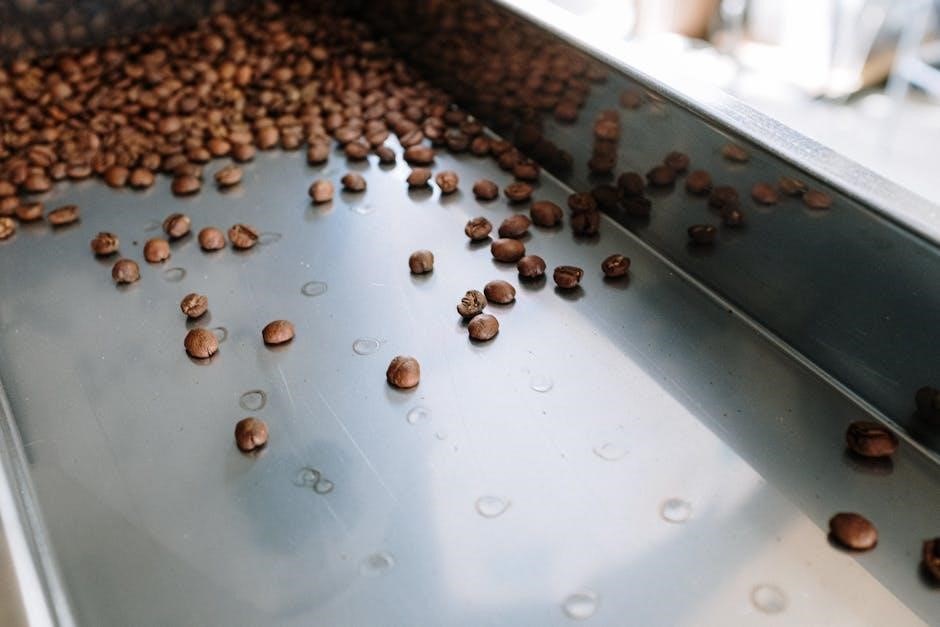Manual food grinders are versatile tools offering precise control over food preparation, enabling users to achieve desired textures effortlessly. They are eco-friendly, cost-effective, and promote healthy cooking by preserving nutrients during grinding. Ideal for various cuisines, these grinders are perfect for processing meats, vegetables, and fruits, ensuring freshness and flavor retention in every dish.
1.1 What is a Manual Food Grinder?
A manual food grinder is a kitchen tool used to process ingredients into desired textures. It operates without electricity, relying on manual effort to grind meats, vegetables, and fruits. Compact and portable, it’s ideal for home use, offering precise control over grind sizes. Its simple design includes a hand-crank and interchangeable dies, making it versatile for various culinary tasks while ensuring minimal waste and maximum flavor retention.
1.2 Importance of Manual Food Grinders in Kitchen Preparation
Manual food grinders play a crucial role in kitchen preparation by offering precision and control over food texture. They enable the processing of meats, vegetables, and fruits with ease, preserving nutrients and flavor. Their versatility in handling various ingredients makes them essential for preparing fresh, healthy meals. Additionally, they promote eco-friendly cooking and are cost-effective, making them a valuable addition to any kitchen setup.
Design and Functionality
Manual food grinders feature ergonomic handles, sturdy cranks, and interchangeable dies, ensuring effortless grinding. Their compact design and durable parts make them ideal for consistent, high-quality food processing at home.
2.1 Mechanical Components of a Manual Food Grinder
A manual food grinder typically consists of a handle, hopper, auger, grinding die, and crank. The handle provides leverage for turning, while the hopper holds food. The auger pushes ingredients through the grinding die, which determines texture. Constructed from durable materials like stainless steel or heavy-duty plastics, these components ensure efficient grinding and longevity of the grinder.
2.2 How the Grinding Mechanism Works
The grinding mechanism of a manual food grinder relies on a crank and gears to convert manual effort into rotational energy. This energy powers a grinding auger, which moves food through the machine. The food is pressed against a stationary die, determining the coarseness of the grind. Users can attach different dies for varied textures, and some models include features like sausage stuffing sleeves for added functionality.
Materials and Durability
Manual food grinders are typically made from durable materials like stainless steel or high-quality plastics, ensuring longevity and resistance to wear and tear during regular use.
3.1 Common Materials Used in Manual Food Grinders
Manual food grinders are typically made from durable materials like stainless steel, carbon steel, or high-quality plastic. Stainless steel is preferred for its rust-resistant and long-lasting properties, while carbon steel offers exceptional strength but requires occasional maintenance. Plastic models are lightweight and easy to clean, though less durable. Some grinders also feature ceramic or aluminum components for enhanced performance and longevity, ensuring reliable use in various kitchen tasks.
3.2 Assessing the Durability of Manual Grinders
Durability depends on materials and construction quality. Stainless steel and high-grade plastics are long-lasting, while improper care can reduce lifespan. Regular cleaning and avoiding abrasive cleaners help maintain performance. Proper storage and handling also prevent wear and tear, ensuring consistent grinding results over time.
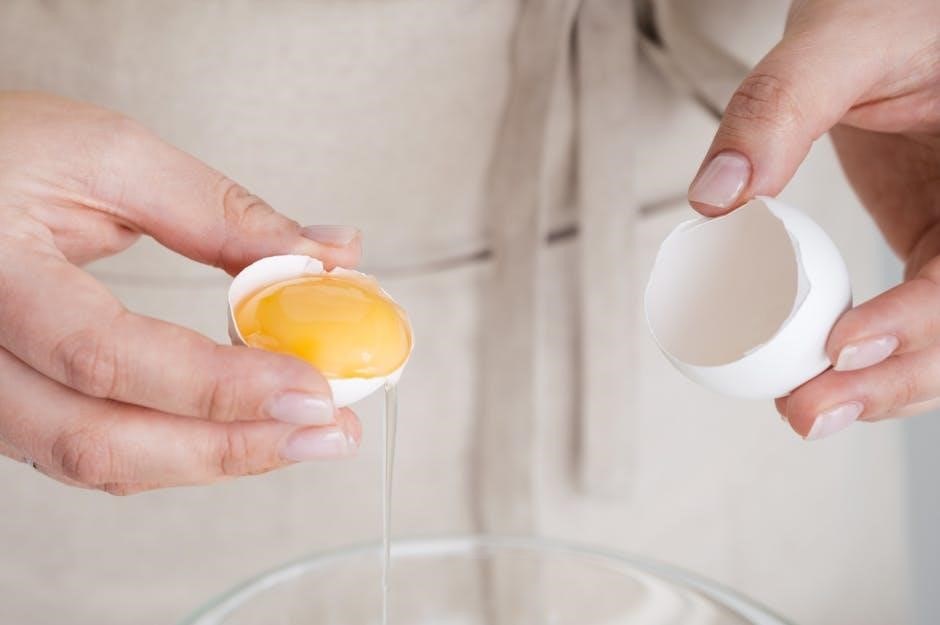
Usability and Ease of Use
Manual food grinders are designed for straightforward operation, allowing users to grind ingredients effortlessly. They handle boneless meats, soft vegetables, and fruits with ease, making them ideal for home use.
4.1 Step-by-Step Guide to Using a Manual Food Grinder
To use a manual food grinder, start by assembling the device according to the manufacturer’s instructions. Feed small, uniform food pieces into the hopper, ensuring they align with the grinding mechanism. Turn the handle steadily to process the food, applying gentle pressure if needed. For tougher materials, use the provided crank or lever for extra force. Collect the ground food in a bowl and repeat as necessary for desired consistency.
4.2 Tips for Easy Cleaning and Maintenance
Regular cleaning ensures longevity and hygiene. Wash parts with mild soap and rinse thoroughly. Dry components to prevent rust. Lubricate moving parts occasionally. Sanitize with vinegar solution for food safety. Store in a dry place to maintain functionality. Check for wear and tear, replacing worn parts promptly. Cleaning immediately after use prevents food residue buildup, making maintenance effortless and extending the grinder’s lifespan.
Applications in Different Cuisines
Manual grinders excel in various cuisines, from processing meats for sausages to finely chopping vegetables and fruits, enhancing flavor and texture in diverse culinary preparations effortlessly.
5.1 Using Manual Grinders for Meat Preparation
Manual grinders excel in meat preparation, offering precise control over texture and consistency. They efficiently process various meats, ensuring even grinding and minimal waste. With interchangeable dies, users can achieve fine, medium, or coarse grinds, perfect for sausages or burgers. The stainless sausage stuffing sleeve further enhances versatility, making manual grinders indispensable for homemade meat dishes. They are also easy to clean and maintain, ensuring longevity and hygiene.
5.2 Grinding Vegetables and Fruits with a Manual Grinder
Manual grinders efficiently process vegetables and fruits, offering a healthy way to prepare ingredients for sauces, salads, or juices. Use coarse dies for chunky textures or finer ones for smoother results. Soft fruits like berries and harder vegetables like carrots can be ground with ease. This method preserves nutrients and flavors, ensuring fresh and vibrant dishes. For softer textures, pulse grinding is recommended.
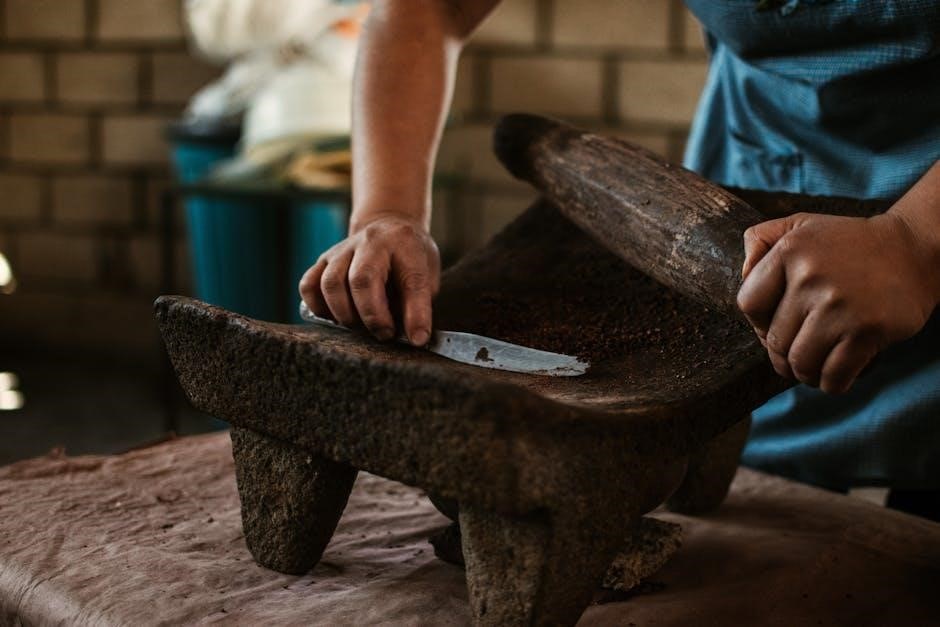
Safety Precautions
Always handle sharp components with care, wear protective gloves, and keep fingers away from grinding areas. Regularly inspect parts for wear and tear to prevent accidents.
6.1 Handling Sharp Parts Safely
Always handle sharp components like blades and grinding plates with care. Store them separately to avoid accidents. Use protective covers when not in use. Ensure hands are dry and clean before handling. Never touch sharp edges directly. Regularly inspect for damage or dullness, as worn parts can pose risks. Proper handling ensures longevity and prevents injuries, making your grinding process safer and more efficient.
6.2 Preventing Accidents While Grinding
To ensure safety, always handle sharp components with care and keep fingers away from blades. Secure the grinder firmly on a stable surface and apply steady, controlled pressure. Avoid overloading the grinder, as this can cause slipping or jams. Regularly inspect for worn or damaged parts and replace them promptly. Proper maintenance and cautious operation are key to preventing accidents and ensuring safe, efficient grinding.
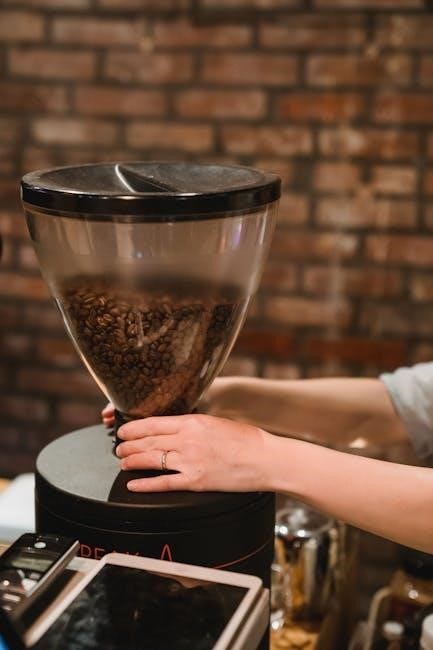
Accessories and Additional Features
Manual food grinders often come with interchangeable dies for varying grind sizes and sausage stuffing attachments, enhancing versatility. They may also include dishwasher-safe parts for easy maintenance.
7.1 Interchangeable Dies for Different Grinding Sizes
Manual food grinders often feature interchangeable dies, allowing users to customize grinding sizes. Fine, medium, and coarse dies cater to various textures, ensuring versatility. This feature is especially useful for preparing meats, vegetables, and fruits, enabling precise control over the final product. Cleaning and maintaining these dies is straightforward, making them a practical addition to any kitchen setup for consistent and high-quality results.
7.2 Sausage Stuffing Attachments
Manual food grinders often come with sausage stuffing attachments, allowing users to efficiently fill casings with ground meat. These attachments, typically made of durable materials like stainless steel, simplify the process of creating homemade sausages. They ensure even filling and minimize waste, making sausage preparation both fun and efficient for home cooks and culinary enthusiasts alike.
Comparison with Electric Grinders
Manual food grinders offer portability and cost-effectiveness without electricity, while electric grinders provide speed and efficiency for bulk processing, making each suitable for different kitchen needs and preferences.
8.1 Advantages of Manual Grinders Over Electric Ones
Manual grinders offer portability, no electricity requirements, and lower costs. They are quieter, provide better control over grinding texture, and retain more nutrients. Ideal for small batches, they are eco-friendly, durable, and easy to clean, making them a practical choice for home use and outdoor activities, while also promoting healthier cooking by avoiding overheating during the grinding process.
8.2 Situations Where Electric Grinders are More Practical
Electric grinders excel in high-volume tasks, such as bulk meat processing, offering speed and efficiency. They are ideal for commercial kitchens or large families, reducing labor and time. For consistent results in industrial settings, electric grinders are preferred due to their power and capacity, making them a better choice for heavy-duty grinding needs compared to manual options.
Budget and Cost Considerations
Manual food grinders are budget-friendly, typically priced between $20 to $100, offering durability and versatility for home use, making them a cost-effective option for various grinding needs without compromising on quality or performance.
9.1 Price Range of Manual Food Grinders
Manual food grinders vary in price, ranging from basic models at $20-$50 to more advanced versions priced between $50-$100. High-end grinders, featuring durable materials and multiple accessories, can cost $100-$250. The price depends on the grinder’s quality, materials, and included features, making it accessible for both casual home use and professional-level food preparation needs.
9.2 Cost-Effective Options for Home Use
Manual food grinders offer an affordable solution for home kitchens, with prices ranging from under $50 to $200, depending on features. Basic models provide excellent value for occasional use, while mid-range grinders with interchangeable dies or sausage stuffing attachments are worth the investment for versatility. Durable materials ensure longevity, making them a cost-effective choice for home cooks seeking quality without breaking the bank.
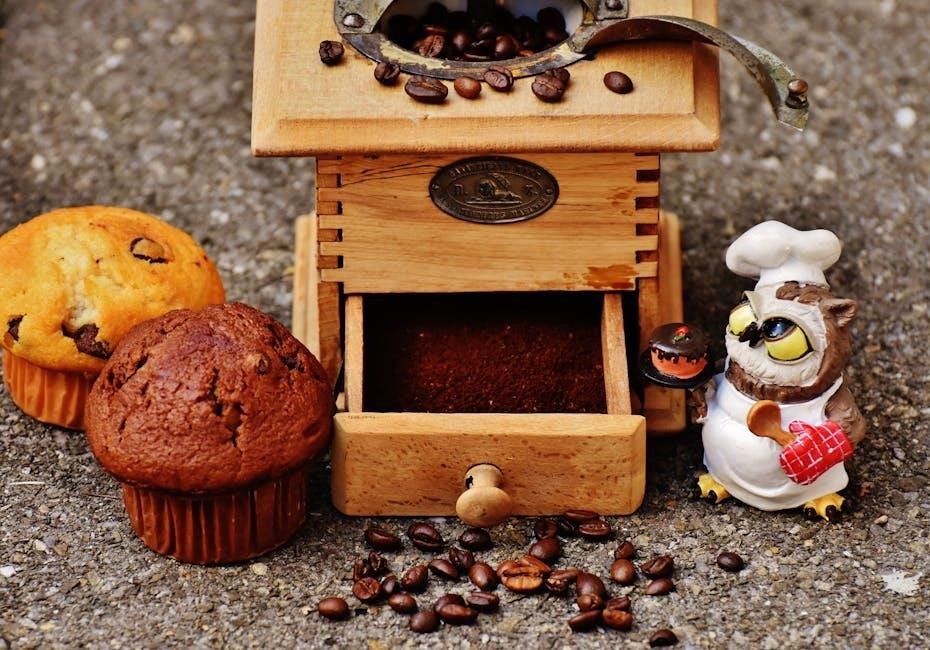
Environmental Impact
Manual food grinders reduce kitchen waste by grinding scraps and leftovers, promoting eco-friendly practices. They are energy-efficient, requiring no electricity, thus lowering carbon footprints effectively.
10.1 Eco-Friendly Benefits of Manual Grinders
Manual food grinders are environmentally friendly as they operate without electricity, reducing energy consumption and carbon emissions. They promote sustainable cooking by allowing the use of organic scraps, minimizing waste. Durable materials and minimal packaging further enhance their eco-friendly profile, making them a responsible choice for kitchen preparation and waste reduction efforts.
10.2 Reducing Kitchen Waste with Manual Grinding
Manual food grinders help minimize kitchen waste by efficiently processing scraps, leftovers, and inedible parts into usable materials. They can grind bones, vegetable peels, and fruit rinds, turning them into compost or biogas. This eco-friendly approach reduces landfill contributions and supports sustainable cooking practices, aligning with environmental goals and promoting resourcefulness in daily meal preparation.
User Reviews and Feedback
Users praise manual food grinders for their durability and performance, especially for meat and sausage preparation. However, some find the process time-consuming and physically demanding.
11.1 Common Praises About Manual Food Grinders
Users often praise manual food grinders for their versatility, ease of use, and ability to retain nutrients in food. They are eco-friendly, cost-effective, and ideal for processing meats, vegetables, and fruits. Many highlight their durability and efficiency, making them a valuable addition to home kitchens for healthy and fresh meal preparation.
11.2 Common Complaints and Areas for Improvement
Users often report manual food grinders can be labor-intensive for large quantities, requiring significant effort and time. Some find the grinding process slow, especially with tough ingredients. Cleaning difficulties and limited accessory options are also commonly cited issues. Users suggest improvements like easier disassembly, durable materials, and enhanced ergonomic designs to make the process more efficient and user-friendly.
Maintenance and Troubleshooting
Regular maintenance involves washing parts with warm soapy water and drying thoroughly. Lubricate moving components to ensure smooth operation. For troubleshooting, check for blockages and ensure all parts are securely locked.
12.1 Regular Maintenance Tips
Regular cleaning is essential to prevent residue buildup. Wash parts with warm soapy water and dry thoroughly to avoid rust. Avoid dishwasher use for sensitive components. Lubricate moving parts periodically to ensure smooth operation. Store the grinder in a dry place to maintain longevity. Cleaning after each use prevents food particles from hardening, making maintenance easier and extending the grinder’s lifespan.
12.2 Solving Common Issues with Manual Grinders
Common issues with manual grinders include clogging and difficulty turning the handle. To resolve these, ensure ingredients are cut into small pieces and avoid overloading. For corrosion, handwash and dry thoroughly. If parts stick, apply a small amount of food-safe lubricant. Regularly check for worn parts and replace them. Always refer to the manufacturer’s guidelines for specific troubleshooting tips.
13.1 Final Thoughts on Manual Food Grinders
Manual food grinders are timeless tools that offer efficiency, durability, and cost-effectiveness. Their versatility in handling various foods, from meats to vegetables, makes them indispensable in kitchens. By providing control over texture and freshness, they enhance culinary experiences. Eco-friendly and promoting sustainable cooking, manual grinders are a practical choice for home cooks and professionals alike, ensuring high-quality results with minimal effort.
13.2 Recommendations for Potential Buyers
When choosing a manual food grinder, prioritize durability and ease of use. Opt for models with stainless steel or BPA-free plastic components for longevity. Consider grinders with ergonomic handles and smooth turning mechanisms for effortless operation. Consider interchangeable dies for versatile grinding options and dishwasher-safe parts for easy cleaning; Read reviews and assess your specific needs to ensure the grinder aligns with your culinary habits and preferences.
